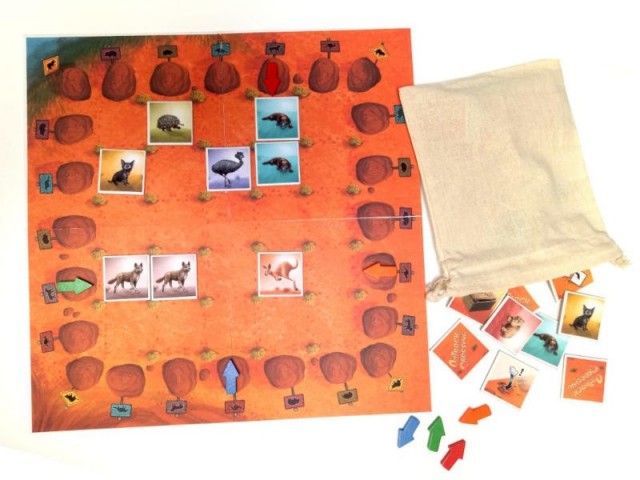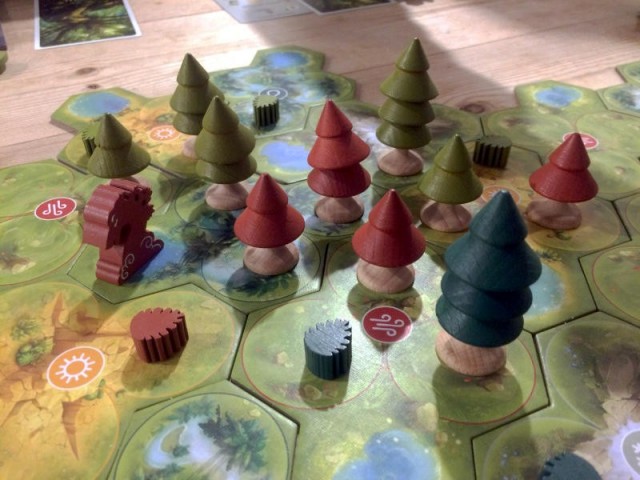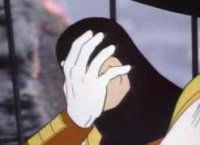It’s hard for me to gauge the buzz in board gaming circles these days, but the release of Star Wars: Outer Rim this last summer completely passed me by. From way over here in Asia, it barely seemed to register at all. The consensus was one of muted approval, a perfectly cromulent game but little more. I’m glad I gave it a chance, because while Outer Rim is a different game than I expected, I am altogether in love with the game I got.
At first glance Outer Rim appears to be in a very particular tradition, that of the pick-up-and-deliver genre. Merchant of Venus is a good starting place for games like this, where the player builds a network of routes to move items around the board. Games like Xia, Merchants & Marauders, and the Firefly board game have all riffed on this in various ways, adding different narrative elements like ship customization and combat. The results are generally very appealing to me, which was what attracted me to Outer Rim in the first place.
Outer Rim certainly has all the trappings of the genre. You take on the role of a scoundrel from the Star Wars universe, and then make your way through the outlying planets in the galaxy. This can be accomplished by moving cargo around the board, but you can also be a bounty hunter or go around the galaxy doing odd jobs. These different activities make you money, which can then be used to buy a better ship and do more stuff. The end goal is to make a name for yourself in the form of fame, and the first person to 10 fame is the winner.
There is a fair bit going on here besides mere pick-up-and-deliver. Furthermore, if you go into Outer Rim with the logistics of trade as your primary desire, you might leave disappointed. The board is actually a long corridor of systems, surprisingly linear in its design as opposed to the large network of locations in, say, Merchant of Venus. It is never very difficult to come up with a route to what you’re doing; either your goal is close or it isn’t. In truth Outer Rim is much more interested in letting players explore the Star Wars setting, doing what they like and making a name for themselves however they like best. It actually has much more in common with big adventure games like Talisman or Arkham Horror, more a light roleplaying experience than an economic one.
In that regard Outer Rim succeeds admirably. Other FFG Star Wars games have sought to recreate specific situations from the beloved movies, usually large-scale conflicts. Games like X-Wing, Rebellion, or Armada all put players in the role of Rebels or Imperials, maybe with some Scum and Villainy thrown in for variety. But Outer Rim is the first board game I’ve played that seems to really recreate the Star Wars universe itself. It represents a vibrant ecosystem of characters, spaceships, and worlds playing out against a backdrop of intergalactic conflict, and the player is given the option to experience it as they think best. You can take the role of famous characters like Han Solo or Lando Calrissian, more obscure ones like Bossk or IG-88, or ones that didn’t even appear in the movies. The game pulls from all three film trilogies, the various TV shows, and even the comic books. And it’s all there for you to explore.
This sense of freedom is pervasive, even as the characters steer you toward different strategies. Indeed, the character you play can make a huge difference in how you interact with the galaxy. Some are well-suited to bounty hunting, while others are really built for smuggling. But there’s never a big penalty for mixing and matching, for taking on a small smuggling job to make some extra credits. You can also build a crew for your ship, made up of characters like Chewbacca or Maz Kanata who might fetch nice bounties if captured by other players. You can even turn on your own crew members and turn them in for bounties if you want to. Outer Rim offers a huge range of narrative possibilities, playing out with surprising specificity.
Other board games have pulled off this trick as well, but what impresses me most about Outer Rim is how efficiently the game does it. Instead of feeling like a sprawling mess of a game with piles of seldom-used subsystems, it feels like it was designed to use the bare minimum of cards and tokens possible. This has been interpreted by some as a lack of content, an obvious attempt to leave something for an inevitable expansion. The game doesn’t really need more cards though, because the variety here is not achieved through huge piles of cards, but through mechanical interactions. The game changes quite a bit based on where NPCs are located, what ships are available, how patrols move, and what characters are in the game. Of all of FFG’s designs, it reminds me most of Battlestar Galactica, another design that relied on permutations of the same relatively simple setup. (Indeed, the games share a designer in Corey Konieczka, here sharing design credit with Tony Fanchi.) Outer Rim feels like a complete and finished experience, and while I would love to see more characters and more planet encounters, it feels like the sort of game that could easily be brought down by an expansion that isn’t quite as well-considered.
Design-wise, Outer Rim is not at all flashy. There are very few elements that feel innovative or particularly unique. But it’s a classic case where basically everything here works well. Fantasy Flight has an unfortunate history of games that are great aside from one particular issue, often the combat. This was also an issue in Merchants & Marauders, the very fun pirate game with combat so overwrought that the players avoid engaging with it. Nothing in Outer Rim feels like a hassle, and the efficiency of the design means that all of the different mechanics come up in basically every game. The lack of “innovative” mechanics also means that you can engage with the game’s fun parts right away. At no point have I felt like I was at war with the rules, or that they were forcing me to learn something before I could enjoy myself. It just works, and it lets the players have fun on the first try. The only bit that feels a little undercooked to me is the use of “secret” cards, special player actions that can be gained on different planet encounters. They aren’t something that kills the flow of the game, but they are the only part of the design that feels like an afterthought.
To be fair, the experience does have some bumpy moments. While the design feels cohesive and intuitive, it does have quite a lot of rules, and there will be some references to those rules while you internalize everything. It’s also not a particularly deep experience. A lot depends on card flips a die rolls, and those who want more control might find themselves frustrated. Perhaps more worryingly, the game takes a while to get going. The first third to the first half of the game are occupied by small stakes, easier jobs and simpler bounties that allow you to get better ships, crew, and gear, thereby allowing you to go for the big stuff. As a result, the early going can feel endless, since most of the fame generated comes in the back half. It’s hardly a deal-breaker, but it’s a 2-3-hour game, and patience is definitely required if you want to see what it has to offer. However, the pace does have its benefits. I always feel like I’m able to explore as much of the galaxy as I want, and a faster pace might cut that short. I am fine with the tradeoff, but others will think it too long-winded. That’s especially true if playing with the full complement of four players.
Look, I’ve only had this game a short time. But in that short time I’ve played a whole lot. I have yet to find any major red flags in Outer Rim that would prevent me from giving it my highest recommendation. It’s exactly the Star Wars game I’ve wanted for years, a chance to play in the universe I’ve loved since I was a kid with very few boundaries. The fact that it’s in a well-designed game with few mechanical issues is just icing on the cake. This is one of my favorite games in a long time.
 Games
Games How to resolve AdBlock issue?
How to resolve AdBlock issue? 
































